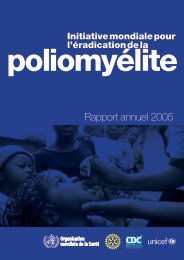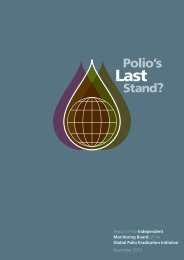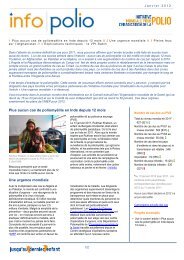(EAP) 2012-2013 - Global Polio Eradication Initiative
(EAP) 2012-2013 - Global Polio Eradication Initiative
(EAP) 2012-2013 - Global Polio Eradication Initiative
Create successful ePaper yourself
Turn your PDF publications into a flip-book with our unique Google optimized e-Paper software.
14 global <strong>Polio</strong> emergency action Plan <strong>2012</strong>-13<br />
pilots 8 prove the Intensified Ward Communication<br />
Strategy (IWCS) can tackle the issue of parents refusing<br />
to vaccinate their children. Restructuring the vaccination<br />
team strategy should help address the issue of insufficient<br />
teams. Pilots designed to improve vaccinator selection/<br />
performance and reduce refusals are showing promise.<br />
Application of the new micro planning templates,<br />
supplemented by <strong>Global</strong> Information System (GIS)<br />
mapping, could solve the problem of missed communities.<br />
Special population strategies, as for nomadic populations,<br />
prove these important groups can now be reached. It<br />
will be crucial to take these innovations to scale rapidly<br />
in the worst-performing LGAs and districts, through the<br />
planned surge support.<br />
Additionally, optimizing the Accountability Framework of<br />
the Presidential Task Force on <strong>Polio</strong> <strong>Eradication</strong>, as well as<br />
the State Task Forces, and continued public reporting of<br />
the Abuja Commitments to hold states and LGAs accountable,<br />
are essential to ensure the Plan's full application, reward<br />
leadership, and sanction those who stand in its way.<br />
The National Emergency Plan <strong>2012</strong> provides specificity (activities,<br />
targets, deadlines, accountability framework and<br />
performance metrics etc.) in each of the following areas.<br />
improving national ownership, oversight and<br />
accountability<br />
On 1 March <strong>2012</strong> the President inaugurated a <strong>Polio</strong><br />
<strong>Eradication</strong> Task Force, chaired by the Minister of State<br />
for Health, to oversee implementation of the National<br />
Emergency Action Plan. The issue of accountability of<br />
all levels of government is one of the key thematic elements<br />
of the plan, in particular the implementation<br />
and close monitoring of the Abuja Commitments. The<br />
country’s Expert Review Committee meets at least<br />
twice a year to provide strategic advice to the Ministry<br />
of Health on polio eradication and to review progress<br />
on implementation of the Emergency Plan.<br />
siA and vaccine plans for <strong>2012</strong>-13<br />
Nigeria is planning for a minimum of two national and<br />
five large-scale subnational supplementary immunization<br />
rounds in <strong>2012</strong>, and a minimum of two national<br />
and four large sub-national rounds in <strong>2013</strong>. A combination<br />
of bOPV and tOPV will be used to stop trans-<br />
8 Presentation of the national Expert Review Committee, Nigeria,<br />
28 March <strong>2012</strong><br />
Action to stop polio now in nigeriA, pAkistAn And AfghAnistAn<br />
mission of the cVDPV2 as well as WPV1 and WPV3.<br />
Subnational rounds will target, at a minimum, the eight<br />
key endemic states of the north.<br />
improving siA quality and monitoring<br />
Under its Emergency Action Plan the interim biannual<br />
programme performance target set for SIA coverage in<br />
Nigeria is >90%. 9 The Plan will target levels surpassing<br />
this in high-risk, mobile population subgroups. Performance<br />
against these targets will be assessed by LQAS.<br />
The Emergency Action Plan elaborates key thematic elements<br />
for improving the quality of immunization activities,<br />
including:<br />
• Heightened LGA accountability and advocacy: intensifying<br />
advocacy at LGA level while re-enforcing<br />
leadership in key high risk states, closely linked to<br />
the monitoring of critical steps outlined in the Abuja<br />
Commitments;<br />
• Improved SIA quality and innovations: the review<br />
and refinement of basic strategies for supplementary<br />
immunization, including a thorough review of current<br />
guidelines, training practices and materials, and<br />
the micro planning process, and incorporating new<br />
approaches including GIS technology;<br />
• Improved SIA planning: developing and implementing<br />
a system of indicators to assess preparations<br />
for each SIA round at LGA level, coupled with<br />
a process for delaying implementation in any LGA/<br />
ward failing to meet satisfactory preparation;<br />
• Human resource surge: the identification and<br />
deployment of adequate human resources to the<br />
highest-risk states and areas (government and partner<br />
resources) from the level of vaccination teams and<br />
community mobilizers up to state level management;<br />
• Reaching chronically-missed children: introducing<br />
and scaling up new interventions to reach chronically-missed<br />
children, including a process of in-depth<br />
9 These targets for priority countries are based on experience<br />
in India and internal data and are interim targets. The ultimate<br />
aim for all priority countries is to reach higher effective<br />
vaccination coverage that goes over the “threshold” as quickly<br />
as possible. Further refinements and data from ongoing studies<br />
and surveillance will assist in deriving more valuable models of<br />
critical target immunity levels in Q2 and Q3 <strong>2012</strong>, which could<br />
lead to revisions of these targets.








![English [pdf 2MB] - Global Polio Eradication Initiative](https://img.yumpu.com/6380394/1/190x245/english-pdf-2mb-global-polio-eradication-initiative.jpg?quality=85)
